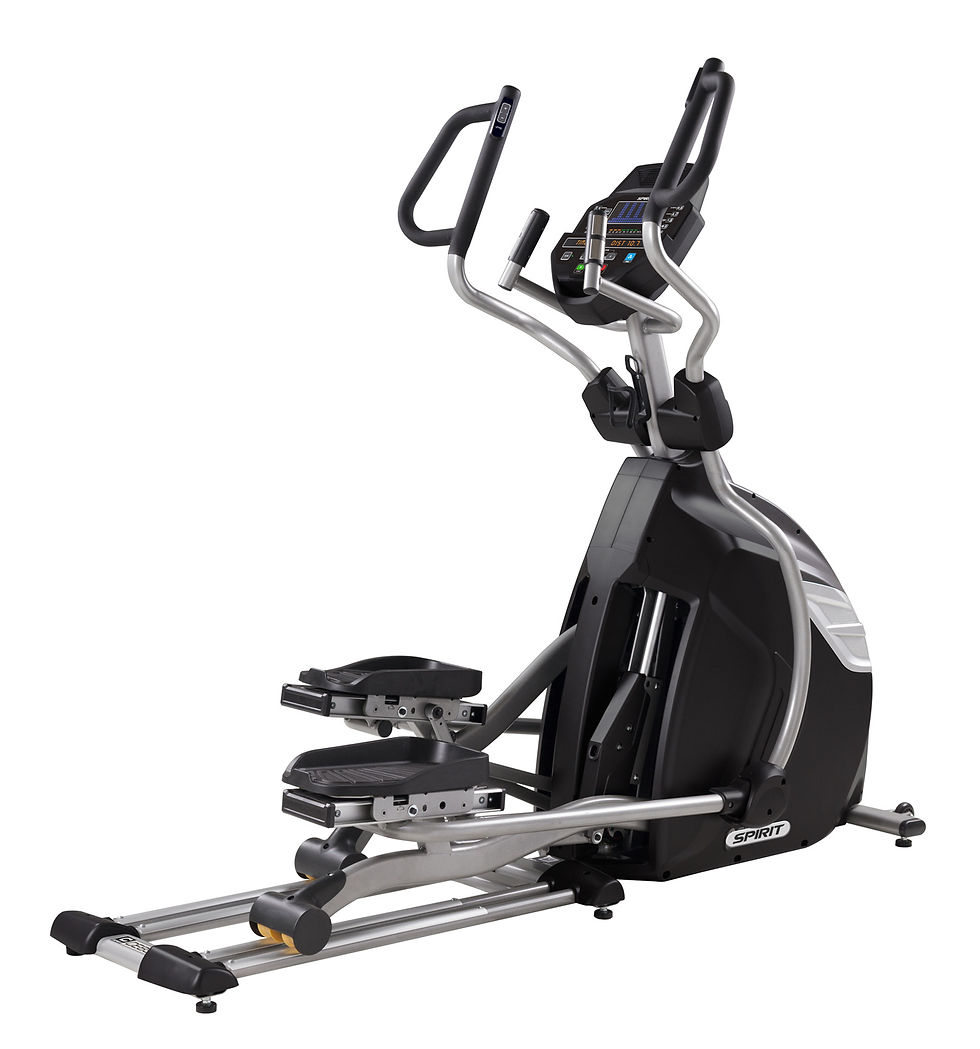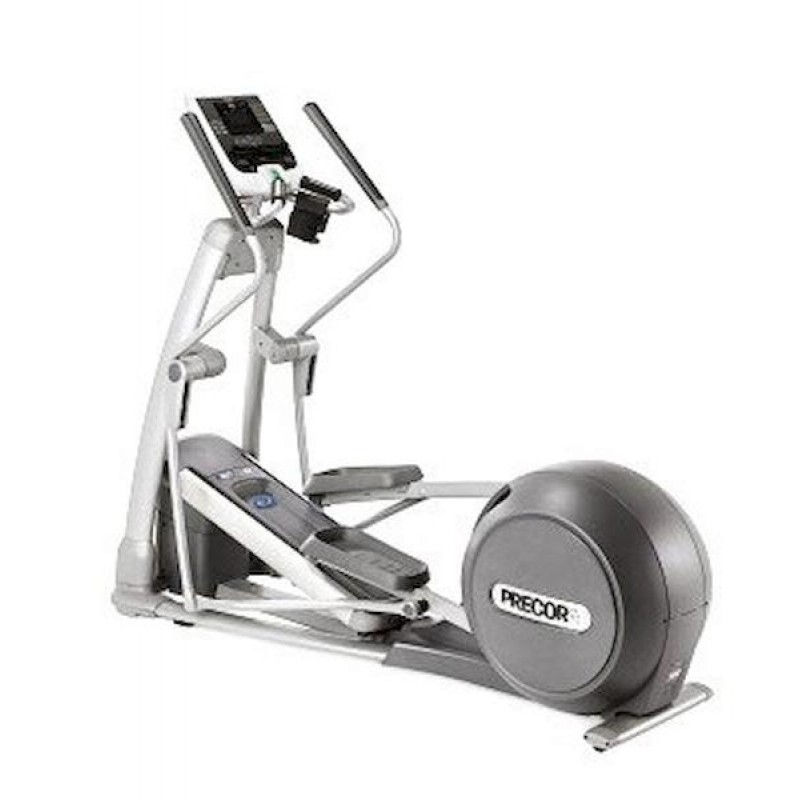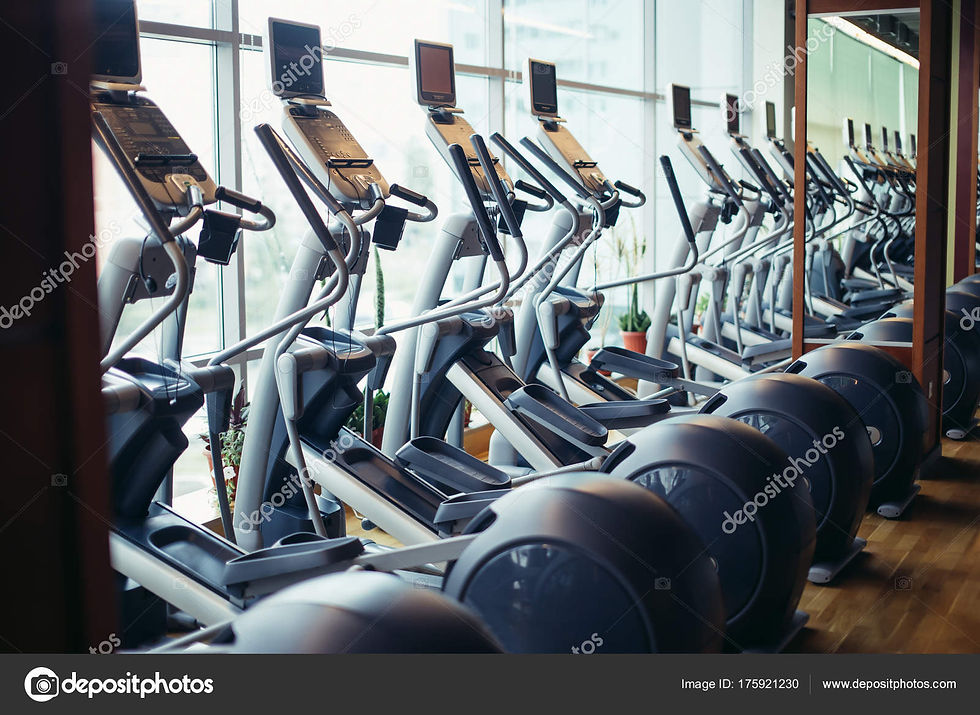Friday, September 17, 2021 – Elliptical Trainers
- Mary Reed

- Sep 17, 2021
- 8 min read

The photo is of an elliptical trainer at the Addison Athletic Club. My knee doctor recently told me the recumbent bike and elliptical trainer are the best physical therapy for a bad knee. He said he had a bad knee and could barely walk, and the elliptical trainer changed his life. I have used elliptical trainers before, but usually preferred the long-stride ones. They didn’t seem to make me so out of breath. However, since my knee strain issues, I have tried the different kinds of elliptical trainers, and they do make my knee feel better. I was hesitant to try them lately, because it is painful for me to walk right now. But the elliptical trainer does not put any pressure on your knee, so it doesn’t hurt. There are elliptical trainers where you hold onto curved bars that move, exercising your arms at the same time. I like those too. Watched a woman today who looked like the Energizer Bunny on the elliptical trainer. I don’t go that fast. I just do the best I can and hope it is building up the cartilage in my knee. Let’s learn more about elliptical trainers.

According to Wikipedia, an elliptical trainer or cross-trainer is a stationary exercise machine used to stair climb, walk or run without causing excessive pressure to the joints, hence decreasing the risk of impact injuries. For this reason, people with some injuries can use an elliptical to stay fit, as the low impact affects them little. Elliptical trainers offer a non-impact cardiovascular workout that can vary from light to high intensity based on the speed of the exercise and the resistance preference set by the user.
Elliptical trainers first entered the market in the 1990s, invented by Precor Inc.
Most elliptical trainers work the user's upper and lower body, although some models do not have moving upper body components. Though elliptical trainers are considered to be minimal-impact, they are an example of a weight-bearing form of exercise. They can be self-powered by user-generated motion or need to be plugged in for adjustment of motion and/or for supplying their electronic consoles and resistance systems.

History
Elliptical riders use an arrangement of links known to the kinematics community as four-bar linkage. The pedals are attached to the floating link referred to as the coupler. The first published work on the subject of elliptical path generation is given in 1988 by researchers at Purdue University in which the path of a point on the floating link is shown to approximately follow an elliptical shape. In 1995, Precor introduced the Elliptical Fitness Crosstrainer or EFX, the first piece of exercise equipment to allow the foot to roll from heel to toe just like in running. Its patented mechanism weds a rear flywheel with a forward foot pedal, creating a smooth, elliptical movement. This is key to foot comfort and reduces numbing of the foot experienced on other stationary cardio equipment.
This approach is classified as "low impact," as it keeps a person's heels in contact with the pedals, reducing muscle and tendon stress.

Types
There are three types of elliptical trainers, categorized by the location of the motor or "drive." The oldest elliptical design is the "rear-drive" type, the second-generation elliptical design is the "front-drive" type, and the most recent elliptical design is the "center-drive" type.
On some models, the incline of sloping roller-ramps beneath the pedal-links can be adjusted to produce varying pedal-motion paths. An adjustable ramp — whether automatic or manual — alters the angle of the elliptical path which can vary hip actuation as well as vary the stride length. This can allow a user to alter his or her workout to target various lower body muscles. In addition to the lower body, elliptical workouts are known to target the whole body. While mostly targeting the glutes, hamstrings and calves, ellipticals can also target the core, triceps, biceps and shoulders, depending on the workout. Some elliptical trainers even enable exercisers to use preset programs to automatically vary incline, resistance and stride length over the course of a workout. In addition, some elliptical trainers can be driven in either a forward or a reverse direction.
Elliptical trainers are primarily driven by the user's legs, and most are combination designs having handle-levers attached to each pedal-link to enable some burden on the arms and to provide a secondary source of driving power. The user grips the handles below shoulder height and pushes and pulls the arms while shuffling the feet back and forth within elliptically shaped paths. Thus, the oscillating handle-motions are dependent on — and coordinated with — the constrained pedal-motions. Some poorly designed machines are too dependent on the user's leg power, producing excessive handle speeds due to mechanical ratios that do not provide enough mechanical advantage to the handle-levers. Consequently, such machines might feel to the user as if his arms are simply "going along for the ride" rather than performing a meaningful portion of the work. Better models of elliptical trainers offer a more balanced — or even harmonious — combination of arm and leg exercise in useful, proper ratios.
Some manufacturers produce durable commercial models made to withstand frequent use in a fitness club environment at prices that can be in excess of $4,000. The average consumer is looking for an elliptical machine for home use which often will cost between $1,000 – $2,000 for a good quality, durable machine with an excellent warranty and packed with features to help track workouts and keep the user distracted. More expensive elliptical trainers — especially commercial machines — are more likely to offer more features such as extensive programs and better adjustment options.

Benefits
An elliptical cross trainer is comparable to a treadmill in its exertion of leg muscles and the heart. Ellipticals produce an intermediate range of leg motion between that of stationary bikes and treadmills.
In a 2010 study, 9 males and 9 females were chosen to exercise at the same rating of perceived exertion on the treadmill or elliptical and found that energy expenditure and oxygen consumption were the same in the two forms of exercise equipment. Thomas Altena, a professor of nutritional and exercise physiology at the University of Missouri, measured oxygen retention, lactic acid build-up, heart rate and perceived rate of exertion to compare treadmills and elliptical trainers, finding that the "physiological responses associated with elliptical exercise were nearly identical to treadmill exercise." However, it is important that the resistance set on the elliptical machine is at a relatively high setting, depending on the user.
Since users do not take their feet off the pedals, there is no footfall noise in contrast with other fitness trainers such as treadmills.
A 2002 study by the University of Idaho shows that varying the stride length on the elliptical trainer can recruit a larger variety of muscle groups. The study also showed that as the stride is lengthened, more calories are burned without any higher rate of perceived exertion by the user. This study is in agreement with the claims made about the adjustable stride length feature on some newer ellipticals.
According to Sara Lindberg’s June 21, 2019 article “10 Benefits of an Elliptical Machine Workout” at healthline.com, if you typically need to wait in line to use your gym’s elliptical machine during peak hours, you’re not alone. The elliptical trainer is one of the most sought-after cardio machines at fitness centers. It’s also a top choice for home exercise equipment.
So, what is it about this low-impact machine that makes it so popular? Check out these 10 benefits and decide for yourself.

1. Boost your stamina and cardio
capacity
Aerobic exercise, also known as cardio, is a key part of a balanced exercise routine. When you do aerobic exercise, your heart and lungs need to work harder to provide your muscles with more blood and oxygen.
The elliptical machine allows you to get a good aerobic workout, which can strengthen your heart, lungs and muscles. This, in turn, can help build your stamina and endurance.
With an elliptical you can perform both high-intensity interval training, as well as steady-state cardio workouts.

2. Burn a lot of calories
If you’re looking for a way to crush your calorie burn in a short amount of time, jump on the elliptical. Depending on how much you weigh, this cardio machine can burn about 270 to 400 calories in 30 minutes. The lower end of the range represents a person weighing 125 pounds, while the higher end is for someone weighing 185 pounds.
Burning more calories than you consume can help you lose weight. To boost your calorie burn, consider increasing the intensity of your elliptical workouts.

3. Put less stress on your joints
When the elliptical hit the cardio machine scene back in the 1990s, runners with achy joints and overuse injuries rejoiced at the thought of being able to train their cardiovascular system while relieving some of the pressure on their joints.
Your knees, ankles, hips and other joints can take a beating when running or doing other high-impact cardio exercises. Since your feet never lift off the pedals with an elliptical, this machine offers a low-impact type of cardio workout.
A 2014 study from a database at the National Institutes of Health showed that an elliptical workout can significantly reduce weight-bearing compared to running, jogging and similar workouts. In other words, with an elliptical, you can continue training without the wear and tear that comes with high-impact exercise.

4. Get an upper and lower body workout
An elliptical machine with handles is one of the few cardio machines that can provide you with both an upper- and lower-body workout. The key to maximizing the upper-body benefits is to distribute your weight and resistance evenly. In other words, pump your arms just as fast as you’re moving your legs.
When done correctly, the elliptical can target your glutes, hamstrings, quads, chest, back, biceps, triceps and core muscles.

5. Burn body fat
Due to its high-calorie burn ability, an elliptical can help you lose body fat and tone up your muscles in a shorter amount of time, especially if you focus on interval work. To maximize fat-burning, you’ll need to focus on the intensity of your workouts, according to the National Institutes of Health.
Consider adding interval training to your elliptical workouts with a 2-to-1 ratio: 30 seconds of high-intensity work followed by 15 seconds of recovery or 60 seconds of high-intensity work followed by 30 seconds of recovery. Do not stop moving your legs during the recovery periods. Continue to move the pedals, but at a slower pace.

6. Target specific leg muscles
You can change both the resistance and incline of the foot pedals on an elliptical. By doing this, you can target different muscles in your lower body including your quads, glutes, hamstrings and calves.
By increasing the incline, you may feel the back side of your lower body burning. If you adjust the foot pedals lower, you may feel your quads working harder. Plus, since the foot pedals go in reverse, you can change the direction of your stride and focus more on your hamstrings and glutes.

7. Improve your balance
Weight-bearing exercise can help strengthen your bones. But did you know it can also improve your balance? If you stand up straight and let go of the elliptical handles, you can target your core muscles and work on your balance.
Just make sure the resistance and incline are set at a manageable level so you can use the elliptical machine safely without using the handles.

8. Maintain fitness after injury
If you’re nursing an injury and can’t participate in your regular physical activities, working out on an elliptical can be a great way to build or maintain your fitness. Since it’s a low-impact exercise, it puts a lot less stress on your joints than high-impact workouts, like running, jogging or jumping.
Working out on an elliptical after an injury may help you regain full range of motion. It can also help strengthen your muscles and joints, while taking the stress off the injured area.

9. Enjoy a variety of options
Elliptical machines usually offer a variety of pre-programed exercise routines that mimic hill climbing, interval training and other customizable options that help you get the type of workout you want.

10. Learn quickly
One of the advantages of an elliptical is that it doesn’t take long to learn how to use it. Although the learning curve with this machine is fairly easy, you may want to ask a personal trainer for guidance if you haven’t used one before. He or she can give you tips on how to use it correctly and the type of workout that may be best for your fitness goals.
When starting out on the elliptical, you may want to only use the foot pedals. Once you get used to the movement of the machine, you can add the handles.




Comments